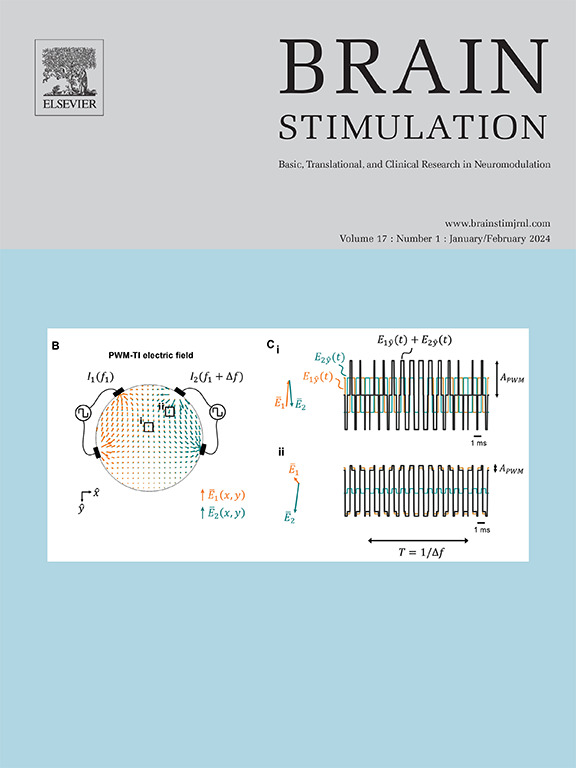Statistical method accounts for microscopic electric field distortions around neurons when simulating activation thresholds
IF 7.6
1区 医学
Q1 CLINICAL NEUROLOGY
引用次数: 0
Abstract
Introduction
Notwithstanding advances in computational models of neuromodulation, there are mismatches between simulated and experimental activation thresholds. Transcranial Magnetic Stimulation (TMS) of the primary motor cortex generates motor evoked potentials (MEPs). At the threshold of MEP generation, whole-head models predict macroscopic (at millimeter scale) electric fields (50–70 V/m) which are considerably below conventionally simulated cortical neuron thresholds (175–350 V/m).
Methods
We hypothesize that this apparent contradiction is in part a consequence of electrical field warping by brain microstructure. Classical neuronal models ignore the physical presence of neighboring neurons and microstructure and assume that the macroscopic field directly acts on the neurons. In previous work, we performed advanced numerical calculations considering realistic microscopic compartments (e.g., cells, blood vessels), resulting in locally inhomogeneous (micrometer scale) electric field and altered neuronal activation thresholds. Here we combine detailed neural threshold simulations under homogeneous field assumptions with microscopic field calculations, leveraging a novel statistical approach.
Results
We show that, provided brain-region specific microstructure metrics, a single statistically derived scaling factor between microscopic and macroscopic electric fields can be applied in predicting neuronal thresholds. For the cortical sample considered, the statistical method matches TMS experimental thresholds.
Conclusions
Our approach can be broadly applied to neuromodulation models, where fully coupled microstructure scale simulations may not be computationally tractable.

统计方法解释了模拟激活阈值时神经元周围的微观电场畸变。
导论:尽管神经调节的计算模型取得了进展,但模拟和实验激活阈值之间存在不匹配。经颅磁刺激初级运动皮层产生运动诱发电位(MEPs)。在MEP产生的阈值,全头部模型预测宏观(毫米尺度)电场(50-70 V/m),大大低于常规模拟的皮层神经元阈值(175-350 V/m)。方法:我们假设这种明显的矛盾部分是由大脑微观结构引起的电场扭曲的结果。经典的神经元模型忽略了相邻神经元的物理存在和微观结构,并假设宏观场直接作用于神经元。在之前的工作中,我们进行了先进的数值计算,考虑到现实的微观区室(例如,细胞,血管),导致局部不均匀(微米尺度)电场和改变神经元激活阈值。在这里,我们将均匀场假设下的详细神经阈值模拟与微观场计算结合起来,利用一种新的统计方法。结果:我们表明,提供特定大脑区域的微观结构指标,微观和宏观电场之间的单一统计衍生比例因子可以用于预测神经元阈值。对于所考虑的皮质样本,统计方法符合经颅磁刺激的实验阈值。结论:我们的方法可以广泛应用于神经调节模型,其中完全耦合的微观结构尺度模拟可能无法计算处理。
本文章由计算机程序翻译,如有差异,请以英文原文为准。
求助全文
约1分钟内获得全文
求助全文
来源期刊

Brain Stimulation
医学-临床神经学
CiteScore
13.10
自引率
9.10%
发文量
256
审稿时长
72 days
期刊介绍:
Brain Stimulation publishes on the entire field of brain stimulation, including noninvasive and invasive techniques and technologies that alter brain function through the use of electrical, magnetic, radiowave, or focally targeted pharmacologic stimulation.
Brain Stimulation aims to be the premier journal for publication of original research in the field of neuromodulation. The journal includes: a) Original articles; b) Short Communications; c) Invited and original reviews; d) Technology and methodological perspectives (reviews of new devices, description of new methods, etc.); and e) Letters to the Editor. Special issues of the journal will be considered based on scientific merit.
 求助内容:
求助内容: 应助结果提醒方式:
应助结果提醒方式:


